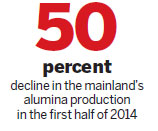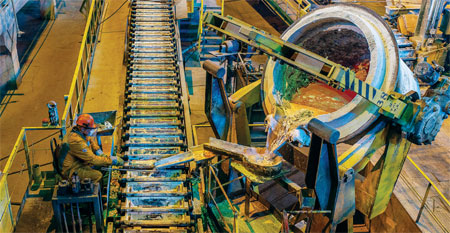Aluminum shortage seen to worsen
Updated: 2014-11-01 07:45
By Luo Weiteng in Hong Kong(HK Edition)
|
|||||||
|
An aluminum plant operated by United Company RUSAL at Sayanogorsk in Russia. With the shift from steel to aluminum in the automotive sector and the growing demand for aluminum, shortage of the metal is expected to worsen in the next few years. Provided to China Daily |
Russia's United Company RUSAL - the world's largest aluminum company - has predicted that demand for the metal, especially by the auto industry, will exceed supply in the years to come.
The company's deputy executive officer Oleg Mukhamedshin told China Daily that the shortage, estimated at about 1.5 million tonnes this year, is expected to widen rapidly with global consumption projected to rise to 66 million tonnes by 2018. RUSAL is said to account for almost nine percent of the global primary aluminum production and a similar amount of the total alumina output worldwide.
Unsurprisingly, RUSAL's share price on the Hong Kong stock exchange has risen by 17.36 percent from July to HK$4.26 ($0.55) apiece, despite occasion faltering. The benchmark indicator increased by a slight 1.90 percent in the same period.
Meanwhile, French bank Natixis Global Asset Management, said in a report published on Oct 14 that Indonesia's ban on exports of unprocessed raw materials and China's efforts to curtail production overcapacity have contributed to the global aluminum shortage.
Mukhamedshin said the shift from steel to aluminum in the automotive sector "will be a game changer for the industry" as seen by US Ford Motor Co's recent move to change its truck model.
By 2020, he said, aluminum will replace steel in about 70 percent of hoods in the global automotive segment.
The major impetus of growth in the global aluminum industry is expected to stem mainly from the wider use of the metal in building cars and trucks, said Mukhamedshin, adding that the increase in demand will reach five million tonnes by 2018. The demand by other users, including construction, packaging and electrical applications, will add up another 40 percent of consumption, he predicted.

Overcapacity is no longer a problem facing the aluminum industry. Based on projected demand surge, global investment houses and commodity traders have been bullish about aluminum futures.
For instance, Natixis predicted that the average price of the metal will increase to $2,070 a ton this year on the London Metal Exchange from the current price of about $2,000. It said the metal's price could go up further to $2,240 a ton in 2016.
Mukhamedshin said producers are not expected to rev up output anytime soon despite the price increase. There are many other factors to discourage them from doing so, he added.
"This is because of cheap power constraints, labor contracts, raw materials, one-off restart costs, restocking the internal smelter supply chain and other issues," Mukhamedshin said.
"In fact, we don't see the market moving to balance in the next four years," he said, adding that the shortage is expected to be around for quite a while.
Demand in China, which is the world's largest producer and consumer of aluminum, is forecast to maintain an average growth rate of about 13 percent in the foreseeable future, said Mukhamedshin.
Output of the mainland's domestic alumina industry fell by 50 percent in the first half of 2014, following an Indonesian ban on bauxite and alumina exports, according to China Aluminium Network.
However, as monthly production figures from the International Aluminium Institute showed that, with average daily production outside of China falling to 66,500 tonnes in September 2014, the mainland's daily output of 68,030 tonnes in September was a new record high - representing an annual growth of 7.2 million tonnes.
Mukhamedshin said China's current supply surplus is quickly absorbed by buoyant domestic demand.
sophia@chinadailyhk.com
(HK Edition 11/01/2014 page8)
